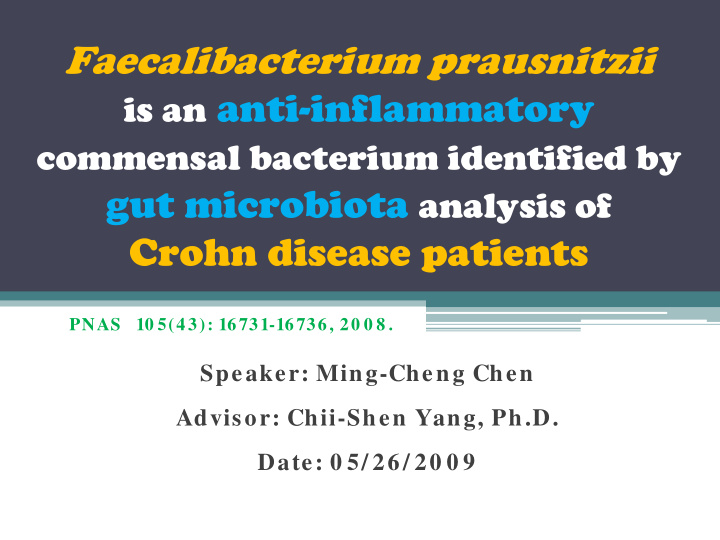



Faecalibacterium prausnitzii anti-inflammatory is an commensal bacterium identified by gut microbiota analysis of Crohn disease patients PNAS 10 5(43): 16731-16736, 20 0 8 . Speaker: Ming-Cheng Chen Advisor: Chii-Shen Yang, Ph.D. Date: 0 5/ 26/ 20 0 9
1 Introduction of the Crohn disease • inflammatory bowel disease (IBD) • autoimmune disease • affect any part of the gastrointestinal tract • in westen country, 1/ 1000 population get the disease The exact cause of Crohn disease is still unknown !
2 involved in Crohn disease The common sites Ileocolic Colonic Ileal
3 Symptoms • Diarrhea • Blood in your stool • Ulcer • At risk of malnutrition • Reduced appetite and loss weight • Also increases the risk of cancer in the area of inflammation…
4 Treatments and drugs Actually ,there is no cure for Crohn disease. • Anti-inflammatory drugs • Immune system suppressor • Antibiotics • Others : anti-diarrheals pain relievers… • Surgery
5 Some possible theories for the disease The exact cause of Crohn disease is still unknown ! 1) Persistent pathogenic infection 2) Dysbiosis 3) Defective mucosal barrier function 4) Defective microbial clearance 5) Aberrant immunoregulation
6 Some important factors of the disease • Genes : CARD15 • Environment: smoking • Immune system • Microbes imbalance
7 The possible pathways for patients Crohn disease Crohn disease to get the Crohn disease
8 Gut flora in human body • normally live in the digestive tract of animals • has about ten times number of microorganism than human cell in the intestines • some bacterium are thought to be capable of causing disease by causing infection or increasing cancer risk for the host
9 The functions of gut flora
10 In the previous study 16S rRNA microarray compare the differences between normal people and patients’ microbial distribution in faecal
11
12 Framework Is the disease related to specific bacteria ? What is the role of the bacteria in inflammatory response ? Which portion of the bacteria is functional ? Can the specific molecule Is it possible to use the counterbalance the bacteria to reduce the dysbiosis in colitis mice ? mortality of colitis mice ?
13 Is the disease related to specific bacteria ? Compare the F. prausnitzii distribution of recurrence and non-recurrence patients A lower proportion of F. prausnitzii on resected ileal Crohn mucosa is associated with endoscopic recurrence.
14 peripheral blood mononuclear cell (PBMC) Add different kinds of bacterium B cell T cell IL 6 TNF α PBMC culture medium IL 12 IL 10 Cytokine Monocyte
What is the role of the bacteria in 15 inflammatory response ? F. prausnitzii shows anti-inflammatory effects on peripheral blood mononuclear cell (PBMC) Proinflammatory cytokines : IL12, IFN γ used to distinguish between strains used to distinguish between strains Anti-inflammatory cytokine : IL10 exhibiting inflammatory regulation property exhibiting inflammatory regulation property
16 Which portion shows anti-inflammatory effect ? Cell membrane Add different portion of bacteria into culture medium DNA Cytoplasm Caco-2 reporter cell line Supernatant
17 Which portion of the bacteria is functional ? F. prausnitzii supernatant abolishes NF- κ B activation in Caco-2 reporter cell line (4) Supernatant of (4) F. prausnitzii , have the anti- (1) (2) (1)(2) (3) inflammation property. (3) The influence on NF- κ B activation was The influence on NF- κ B activation was tested by the SEAP reporter system tested by the SEAP reporter system Secreted Alkaline Phosphatase Assay System ( SEAP )
18 Using TNBS -induce mice to mimic the symptom of crohn disease in human Inject TNBS Colitis mice TNBS=2,4,6-trinitrobenzene sulfonic acid
19 F. prausnitzii exhibits anti-inflammatory effects on TNBS -induced colitis mice Living F. prausnitzii or its supernatant result in a attenuation of colitis with reduced weight loss. Proinflammatory cytokines : IL12, TNF α Antiflammatory cytokine : IL10
Can the specific molecular 20 counterbalance the dysbiosis in colitis mice ? F. prausnitzii and its supernatant tend to counterbalance the TNBS -induced dysbiosis in colitic mice Treatment with either F. prausnitzii or its supernatant tended to counterbalance the dysbiosis observed in colitis control mice for bacteria: C. leptum , C. coccoides , Bacteroides , and F. prausnitzii.
21 Is it possible to used the bacteria to reduce the mortality of colitis mice ? F. prausnitzii and its supernatant can act by a gut-independent route survival rate of 20 days after colitis induction supernatant 100 % 50 % F. parausnitzii dexametasone butyrate 10 % colitis control i.p.(intraperitoneal) injection In the groups treated with live F. prausnitzii or its supernatant, the mortality rate was dramatically decreased. dexametasone butyrate
22 Summary Is the disease related to specific bacteria ? What is the role of the bacteria in inflammatory response ? Which portion of the bacteria is functional ? 100 % Can the specific molecular Use F. prausnitzii as a probiotic Is it possible to used the counterbalance the to counterbalance dysbiosis is a promising strategy in Crohn bacteria to reduce the dysbiosis in colitic mice ? disease treatment! mortality of colitic mice ?
Recommend
More recommend